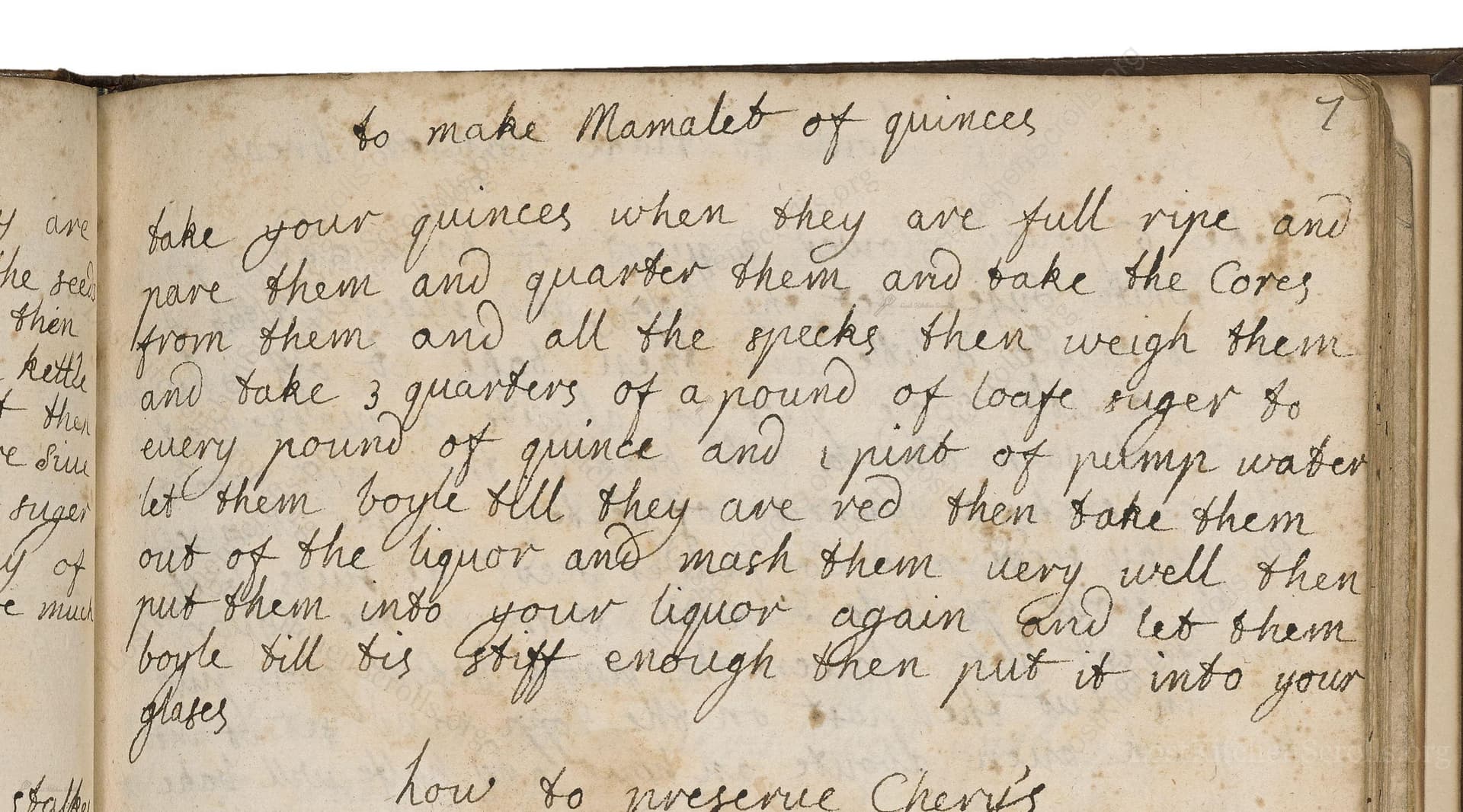To Make Mamalet Of Quinces
From the treasured pages of Receipt book
Unknown Author

To Make Mamalet Of Quinces
"take your quinces when they are full ripe and pare them and quarter them, and take the Cores from them and all the specks then weigh them and take 3 quarters of a pound of loafe suger to every pound of quince and a pint of pump water let them boyle till they are red then take them out of the liquor and mash them uery well then put them into your liquor again and let them boyle till tis stiff enough then put it into your glases"
Note on the Original Text
The recipe is written in the concise, formulaic style typical of early 18th-century manuscript cookery. Quantities are given relative to the weight of fruit, allowing for easy adjustment based on the household's harvest. Spellings like 'boyle' for boil and 'uery' for very are characteristic of the period's variable orthography. Directions assume some prior kitchen knowledge, leaving details like temperature and timing to the cook’s experience. Terms such as 'loafe suger' refer to the large sugar loaves of the day, now replaced by granulated sugar.

Title
Receipt book (1700)
You can also click the book image above to peruse the original tome
Writer
Unknown
Era
1700
Publisher
Unknown
Background
A delightful glimpse into the kitchens of the early 18th century, this historic culinary manuscript promises a feast of recipes, remedies, and perhaps a pinch of mystery. Expect both practical fare and elegant inspiration for the curious cook.
Kindly made available by
Folger Shakespeare Library
This recipe is drawn from an early 18th-century English manuscript, written around 1700 by domestic cooks or housekeepers who recorded family recipes. Quince marmalade, or 'mamalet,' was a luxurious seasonal preserve, often served at the dessert course or as a sweetmeat at banquets. Such preserves were cherished for their intense flavor and jewel-like color, and were a marker of both culinary skill and affluence, as sugar was still a precious commodity. The manuscript reference, 'V.b.272,' indicates it comes from a private recipe collection rather than a published book, offering a glimpse into domestic life and food preservation practices of the period.

Cooks in the 1700s would use a large brass or copper preserving pan over an open fire or on a hearth. Wooden spoons or mashers were used to crush the cooked fruit. Glasses—footed glass bowls or wide-mouthed jars—were the containers of choice for setting and serving the finished preserve. Scales for weighing ingredients were likely balance-type, and water would be fetched or pumped as needed.
Prep Time
15 mins
Cook Time
1 hr 45 mins
Servings
10
We've done our best to adapt this historical recipe for modern kitchens, but some details may still need refinement. We warmly welcome feedback from fellow cooks and culinary historians — your insights support the entire community!
Ingredients
- 2.2 lbs ripe quinces (peeled, cored, quartered)
- 1.65 lbs white granulated sugar (substitute for loaf sugar)
- 2 cups water
Instructions
- Begin by selecting fully ripe quinces.
- Peel them, cut them into quarters, and remove cores and blemishes.
- Weigh the prepared fruit: for every 2.2 pounds of quince, measure out 1.65 pounds of white granulated sugar.
- Place the quince pieces in a large saucepan with 2 cups of water per 2.2 pounds of fruit.
- Bring to a gentle boil and cook the quinces until they turn a deep rosey red, usually 45-60 minutes.
- Remove the fruit with a slotted spoon and mash it well.
- Retern the mashed quince to the cooking liquid and continue simmering, stirring often, until the mixture thickens and becomes stiff enough to hold its shape when spooned onto a plate (another 30-45 minutes).
- Spoon the finished paste into sterile jars or glass containers and let cool; it will set into a thick, sliceable preserve.
Estimated Calories
175 per serving
Cooking Estimates
You will spend about 15 minutes peeling and preparing the quinces. The cooking process takes roughly 1.5 to 2 hours altogether. This recipe makes about 10 servings, with each serving around 175 calories.
As noted above, we have made our best effort to translate and adapt this historical recipe for modern kitchens, taking into account ingredients nowadays, cooking techniques, measurements, and so on. However, historical recipes often contain assumptions that require interpretation.
We'd love for anyone to help improve these adaptations. Community contributions are highly welcome. If you have suggestions, corrections, or cooking tips based on your experience with this recipe, please share them below.
Join the Discussion
Rate This Recipe
Dietary Preference
Main Ingredients
Culinary Technique

Den Bockfisch In Einer Fleisch Suppen Zu Kochen
This recipe hails from a German manuscript cookbook compiled in 1696, a time whe...

Die Grieß Nudlen Zumachen
This recipe comes from a rather mysterious manuscript cookbook, penned anonymous...

Ein Boudain
This recipe comes from an anonymous German-language manuscript cookbook from 169...

Ein Gesaltzen Citroni
This recipe, dating from 1696, comes from an extensive anonymous German cookbook...
Browse our complete collection of time-honored recipes



